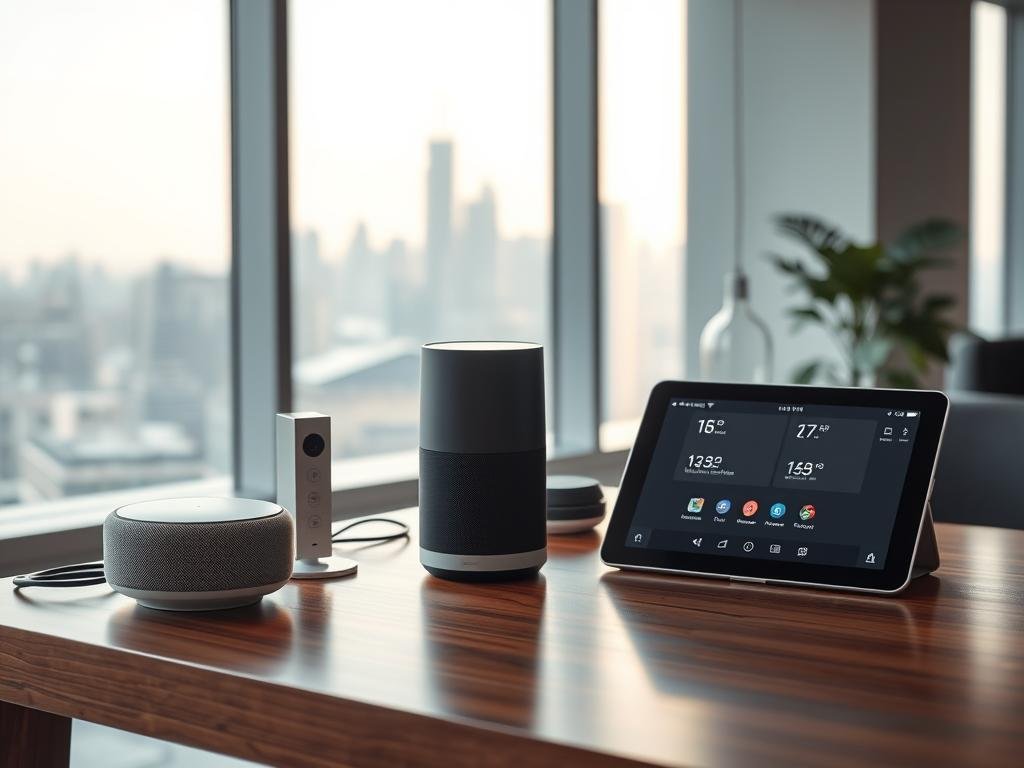IoT Devices Security Guide. Nearly half of U.S. homes will use smart tech this year, and that scale makes you a target if you ignore basic protection.
You need a clear, AI-informed plan that stops common threats before they spread through your network.
This short article shows a step-by-step approach so you can lock down each connected device, limit access, and keep sensitive data out of the wrong hands.
Real incidents like the Mirai botnet and the fish‑tank breach prove how fast attackers move and why unmanaged gear raises risks.
Along the way you’ll build visibility into what’s online, adopt quick wins (change defaults, update firmware, segment Wi‑Fi), and add smarter monitoring as you grow.
For deeper technical context and enterprise-aligned frameworks, see a specialist overview at enterprise IoT analysis and practical home tips at smart home safety.
What IoT means for your connected devices today
Start by naming every connected item in your home and tracing where it sends information.
Define scope: list cameras, thermostats, locks, TVs, speakers, and smart plugs so every product with an IP address is accounted for.
Map data paths: note whether each unit talks direct to the cloud, goes through a hub, or uses a local gateway. Record what information it collects and who can access it.
Many low‑power gadgets run tiny operating systems and lack agent support. They rarely receive firmware updates, which raises real risks to your wider network.
- Document current firmware and update frequency so you can plan safe updates.
- Flag unmanaged or shadow items and require approval before anything joins your Wi‑Fi.
- Group by exposure—exterior cameras vs. indoor sensors—to set the right protection level.
Proprietary protocols and multiple companies complicate centralized controls. For a broader evolution of this technology, read what is iot and how has it.
Why securing IoT matters now: risks, threats, and real-world attacks
Real breaches prove that small, overlooked gadgets can open pathways to massive data loss.
The Mirai outbreak in October 2016 taught a simple lesson: open Telnet and default passwords let attackers build botnets that caused major DDoS outages across the U.S. East Coast.
In another case, a casino’s Wi‑Fi fish‑tank thermometer let attackers move from a trivial sensor to core systems and steal 10 GB of sensitive data.
More recently, cloud credential theft exposed live feeds from roughly 150,000 cameras, showing how a single compromise can cascade across hospitals, factories, and schools.
What these attacks reveal
- Defaults are dangerous: change credentials and disable legacy protocols like Telnet.
- Segmentation matters: isolate smart networks so a single unit cannot reach sensitive databases.
- Cloud risks: stolen credentials amplify impact when many cameras or services share the same control plane.
Common vulnerabilities to fix fast
Prioritize: remove default passwords, enable stronger authentication, and keep firmware current.
| Vulnerability | Impact | Immediate fix |
|---|---|---|
| Default credentials | Botnet recruitment, unauthorized access | Set unique, strong passwords and enable MFA |
| Open legacy protocols (Telnet) | Remote exploitation and scanning | Disable protocols; block at perimeter |
| Lack of segmentation | Lateral movement to sensitive systems | Isolate guest and smart networks on separate VLANs |
| No agent support / limited telemetry | Blind spots for detection | Use network monitoring, NAC, and flow analysis |
Map each unit to the sensitive data it can reach and apply rate limits and monitoring to detect odd traffic. For deeper vulnerability checklists and remediation steps, see this short primer on smart home risks at smart home security vulnerabilities.

IoT devices security guide: step-by-step to protect your smart home
Begin with a simple discovery pass that records model, MAC, firmware, and where each unit sends data.
Inventory and visibility: build a list that logs name, IP, location, firmware version, and the type of information sent to cloud or local systems. This gives you the visibility needed to prioritize risk.
Kill the defaults: change admin usernames and passwords immediately. Disable universal plug‑and‑play and enable multi‑factor authentication where the app or account supports it.
Update strategy: schedule monthly firmware and software checks. Turn on automatic updates when safe and keep a simple rollback plan in case an update breaks functionality.
Device hardening: disable unused services and insecure protocols like Telnet. Close unnecessary ports and remove remote admin access unless you truly need it.
Decommissioning: revoke cloud access, factory‑reset the unit, remove it from controllers, and confirm it no longer appears on your router. Label legacy items that lack updates and plan replacements.
Use the connectivity checklist below and review your inventory quarterly to keep your network protected.

| Action | What to record | Frequency |
|---|---|---|
| Inventory | Model, MAC/IP, firmware, data flows | Quarterly |
| Credentials | Change admin names, strong passwords, enable MFA | At setup and after resets |
| Updates | Firmware/software versions, backup plan | Monthly |
| Decommission | Revoke access, factory reset, remove from controller | When retired |
For troubleshooting common connection gaps and visibility tools, consult a short connectivity checklist to guide the next step.
Fortify your network: segmentation, encryption, and traffic control
Segmentation and encryption are the fast tracks to reducing risk on home networks. Start by separating your gear so a single breach can’t spread.
Create separate VLANs/SSIDs for smart devices and guests
Place all smart devices on their own SSID or VLAN. Keep guests on a different SSID and reserve a private SSID for your phones and laptops. Test that hosts on the smart segment cannot reach your personal systems.
Harden your router: WPA3, strong admin credentials, and automatic updates
Use WPA3, change the admin username, set a strong password, disable WPS, and turn on automatic updates. Keep router firmware current and schedule reboots to apply patches.
Perimeter and internal firewalls to filter malicious traffic
Deploy firewall rules to block unsolicited inbound connections and restrict outbound protocols. Enable DNS filtering and safe‑browsing controls to stop known malicious domains before they reach a device.
Router-level VPN for encrypted internet traffic to and from IoT devices
Consider a router VPN to encrypt all internet traffic. This improves privacy and protection, though it may add latency and often needs a paid service.
| Defensive Measure | Why it matters | Action |
|---|---|---|
| Segmentation (VLAN/SSID) | Limits lateral movement | Place smart devices and guests on separate networks |
| Router hardening | Closes common entry points | WPA3, unique admin name, strong passwords, auto updates |
| Firewall & DNS filtering | Stops malicious traffic early | Block inbound, restrict outbound, enable safe browsing |
| Router VPN | Encrypts outbound/inbound traffic | Configure at router level; expect some latency |
For step-by-step setup and practical tips, review DIY cybersecurity tips to harden your home network and maintain ongoing protection.
Leverage AI-powered security to detect, respond, and recover
Bring smarter monitoring and playbooks into your home network so you spot unusual behavior fast and act before small problems become outages.
AI-driven anomaly detection learns a normal baseline for each device—typical ports, protocols, and traffic patterns. When the model sees sudden spikes, new destinations, or unfamiliar protocols, it flags the activity for review.
SIEM and network monitoring with NAC collect logs from your router, firewall, and controllers. A lightweight SIEM correlates alerts across sources so you see multi‑device patterns that single tools miss.
Integrate your monitoring with network access control so suspicious systems are automatically moved to a quarantine VLAN or DMZ. This limits access to sensitive data and gives you time to investigate without broad disruption.
- Create incident response playbooks that define triage steps, isolation actions, evidence collection, and communications so you can act in minutes.
- Tag high‑risk units missing firmware updates or MFA for tighter controls and closer monitoring.
- Keep clean backups of controller configs and document recovery sequences to restore operation quickly.
- Use vendor feeds and community intel to enrich detections and prioritize fixes for emerging vulnerabilities.
Track mean time to detect, respond, and recover to measure improvement. For detailed examples of AI approaches and enterprise use cases, review an analysis of AI for device protection and a broader outlook on cyber trends at cybersecurity in 2025.
Govern with proven frameworks: NIST CSF, Zero Trust, and modern IAM
Align your home controls with an established cybersecurity framework to reduce gaps and clear ownership.
The NIST Cybersecurity Framework gives you a simple map: Identify, Protect, Detect, Respond, Recover. Use it to turn ad hoc steps into a repeatable program for managing risk across every networked item in your home.
Map your program to Identify, Protect, Detect, Respond, Recover
Start with asset tracking and real‑time lists for every iot device and its data flows. Tie each entry to a protection action like segmentation, encryption, or MFA.
Use monitoring and SIEM-style alerts to detect anomalies. Document response playbooks and test recovery steps so you can restore service fast.
Adopt Zero Trust and SASE principles
Apply least privilege: verify every request before granting access. Treat each device and user as untrusted until proven safe.
Centralize policy enforcement at the edge so protection follows your gear wherever it connects. This reduces lateral risks and simplifies management.
Strengthen authentication with IAM and MFA
Use IAM best practices to separate admin and user roles for cameras, alarms, and controllers. Enable MFA on vendor accounts and rotate tokens regularly.
Assign household roles for patching, monitoring, and incident response to raise accountability and the overall protection level.
| Framework Element | Practical Action | Who Owns It | Frequency |
|---|---|---|---|
| Identify | Asset registry with firmware and data paths | Home owner / admin | Quarterly |
| Protect | Segmentation, encryption, IAM roles, MFA | Network admin | At setup & after updates |
| Detect | Alerts from router/SIEM, NAC quarantine | Observer / monitoring lead | Continuous |
| Respond & Recover | Isolation playbook, backups, runbook | Incident owner | After incidents; test semiannually |
For a practical NIST primer and mapping template, review the framework at NIST CSF overview and adapt the controls to your home context.
Conclusion
,Make the final step simple: lock defaults, monitor traffic, and ask whether each device truly needs network access.
Keep a short, repeatable routine: inventory every iot device, change default passwords, enable MFA, and schedule firmware and software updates. Segment networks and use encryption so one compromise can’t reach everything you care about.
Rehearse response playbooks, keep backups, and retire high‑risk gear before disposal. Apply lessons from Mirai, the fish‑tank breach, and other attacks to reduce risk and lower your exposure over time.
Next step: adopt solutions that automate maintenance and give clear visibility, then review the plan quarterly. Learn practical steps to transform your home at transform your home.
FAQ
What steps should you take first to secure your smart home?
Start by inventorying every connected item on your network and noting firmware versions and manufacturer details. Create a simple map of data flows so you can see where information travels. Then remove or isolate any unknown gadgets, change default credentials, and enable automated updates where available.
How do you manage default passwords and weak authentication?
Replace factory logins immediately and choose long, unique passphrases. Use multi-factor authentication for accounts and services that support it. If a gadget lacks strong auth, place it on a separate guest network or VLAN to limit access.
What’s the best way to keep firmware and software up to date?
Adopt a patching schedule and enable automatic updates when vendors offer them. Track end-of-life notices from manufacturers and retire unsupported models. Prioritize critical security patches and test updates on a single unit before rolling them out broadly.
How can you improve network segmentation for connected products?
Create dedicated SSIDs or VLANs for household tech, guests, and sensitive systems like work laptops. Enforce access controls so smart items can reach cloud services but cannot initiate inbound connections to your main network. Use firewall rules to restrict protocols and ports.
What encryption and router settings should you enforce?
Use WPA3 for Wi‑Fi where possible and strong admin credentials on the router. Turn on router-level automatic updates and disable remote management. Consider a router that supports per-device VPN or DNS filtering to protect outbound traffic.
When should you decommission a product and how do you do it safely?
Retire any model that no longer receives security updates or that you cannot configure to meet baseline protections. Factory-reset before disposal, remove associated cloud accounts, and if possible, destroy storage media that may hold sensitive data.
How do you detect compromised behavior in real time?
Use network monitoring tools that show unusual traffic patterns and unexpected protocols. Implement anomaly detection that flags spikes in outbound connections or communication with known malicious hosts. Pair with logging and alerting so you act quickly.
Can artificial intelligence help protect your network, and how?
Yes. AI-driven systems spot deviations from normal behavior faster than manual methods, prioritize alerts, and can automate containment steps like isolating a suspect unit. Combine AI tools with human review for accurate, low-noise response.
What frameworks should you follow to build a repeatable protection program?
Map your practices to established standards such as NIST CSF and adopt Zero Trust principles for least-privilege access. Use identity and access management with MFA to control who can configure or view critical components.
How do you secure low-power and legacy smart gear that lacks agent support?
Isolate those items on separate networks, restrict their internet destinations, and apply strict firewall rules. Use gateway appliances or network-based controls to provide inspection and protocol filtering without installing agents.
What role do password managers and MFA play in protecting your home network?
Password managers generate and store strong credentials, reducing reuse and weak passphrases. MFA adds a second factor that blocks many takeover attempts. Together they significantly reduce the chance of account compromise.
How should you handle vendor security claims and product selection?
Evaluate manufacturers by their update cadence, transparency about vulnerabilities, and available security features. Prefer brands that publish security advisories, offer regular patches, and support modern encryption and authentication.
What immediate actions should you take if you suspect an attack?
Isolate the affected unit by disconnecting it or moving it to a quarantined VLAN. Change admin credentials, capture logs or traffic samples if possible, and consult vendor support or a professional responder. Restore from known-good backups after remediation.
How do you balance convenience with protection for shared household tech?
Use role-based accounts and guest networks to limit exposure while keeping everyday use simple. Automate security tasks like updates and backups so you maintain safety without daily effort. Educate household members on basic precautions.
Which monitoring tools provide the best visibility without overwhelming you?
Choose tools that offer device discovery, traffic categorization, and prioritized alerts. Solutions that integrate with your router, provide simple dashboards, and allow policy-based blocking give actionable insight without constant noise.
How often should you review and update your protection strategy?
Review policies and inventory quarterly, and reassess risk after any major purchase or firmware change. Perform full audits annually and whenever you learn about new threats or vendor advisories that affect your equipment.
